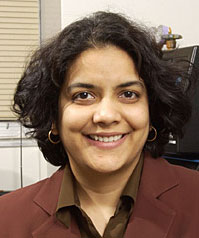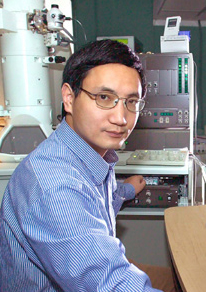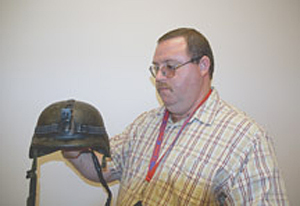| Research
|
Bioinspired polymers intrigue Ames Laboratory chemist Surya Mallapragada. In the past couple of years, she's lectured at conferences all over this country and abroad on her research into self-assembling block copolymers. She's also looked at using polymers as a drug delivery system and as a means to promote nerve regeneration. So it's no wonder that she's literally writing the book on the subject, editing the Handbook of Biodegradable Polymeric Materials and their Applications, due out early next year. "It's extremely important to learn from nature," says Mallapragada, who recently took over as director of the newly renamed Materials Chemistry and Biomolecular Materials program within DOE's Ames Laboratory. "Through collaborative study, we hope to create a new body of knowledge, both experimental and theoretical, to answer several important questions at the intersection of materials, nanotechnology and biology and use those answers to design new bioinspired materials." Mallapragada, who is also an associate professor of chemical engineering at Iowa State University, developed an interest in chemistry from her father, who bought her chemistry sets as a child so they could do the experiments together. She turned that interest and a love of math into a chemical engineering degree at Bombay's Indian Institute of Technology, then left her native India to pursue a Ph.D. at Purdue University. The strength of the chemical engineering program, particularly in polymer research, eventually brought both her and her husband, Balaji Narasimhan, to Iowa State in 1996. She soon began to receive recognition for her work, earning awards for early career achievement from ISU, 3M and the National Science Foundation. In 2002, she was named by MIT's Technology Review as one of the "Top 100 Young Innovators" and won a Global Indus Technovators Award in 2003. Her affiliation with Ames Laboratory began as an associate with a biomedical grant through the Office of Biological and Environmental Research to study using polymer sheaths with nanoscale grooves to help steer nerve cell growth. Subsequently, she worked on other projects supported by Basic Energy "The name change reflects DOE's commitment to the field of biomolecular research," Mallapragada says, "and hopefully we can build on the strong nucleus of research that was already taking place here to make significant strides in this new, expanding area." Submitted by DOE's Ames Laboratory |
|||||||||||||||||||||||
|
El Paso police, Sandia work together on high-tech law enforcement
"El Paso Crime Scene Investigations" may not have the glitter of "CSI: Miami ," but it has some technology and an approach to technology that many in law enforcement very much admire. Through the help of the Border Research and Technology Center (BRTC) — operated by DOE's Sandia National Laboratories from offices in San Diego — and some strong local initiative, that department in a city of 600,000 citizens is providing national leadership. "In the area of teleforensics, the El Paso Police Department is the pathfinding agency," says Sandia's Chris Aldridge, who is BRTC director. Aldridge and the center, with National Institute of Justice funding, helped the El Paso department get started with some equipment in 1999. From there, Commander Michael Czerwinsky and his team have taken the project to new levels. "Our old equipment was bulky, hard to hide, costly, and expensive to maintain," says Sgt. Darwin Armitage, who worked with Sandia's Richard Sparks to put the so-called "Investigators Toolkit" into use. "The new equipment had all the pieces — time-and-date stamps, recording units, cameras, transmitters; and everything was off the shelf," he said. The vice team put the equipment to work with a bang. In its first test, a detective transmitted a conversation at a bar with a tiny camera hidden in a pager, while Armitage sat in the lobby nearby and watched and recorded the entire transaction for evidence using a briefcase full of equipment, including a small monitor. Submitted by DOE's Sandia National Laboratories |



